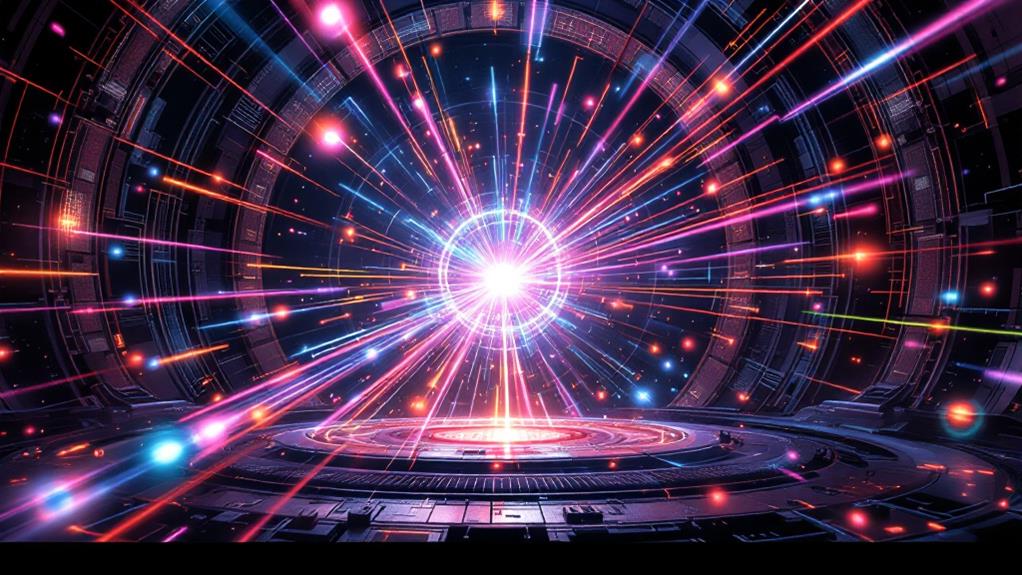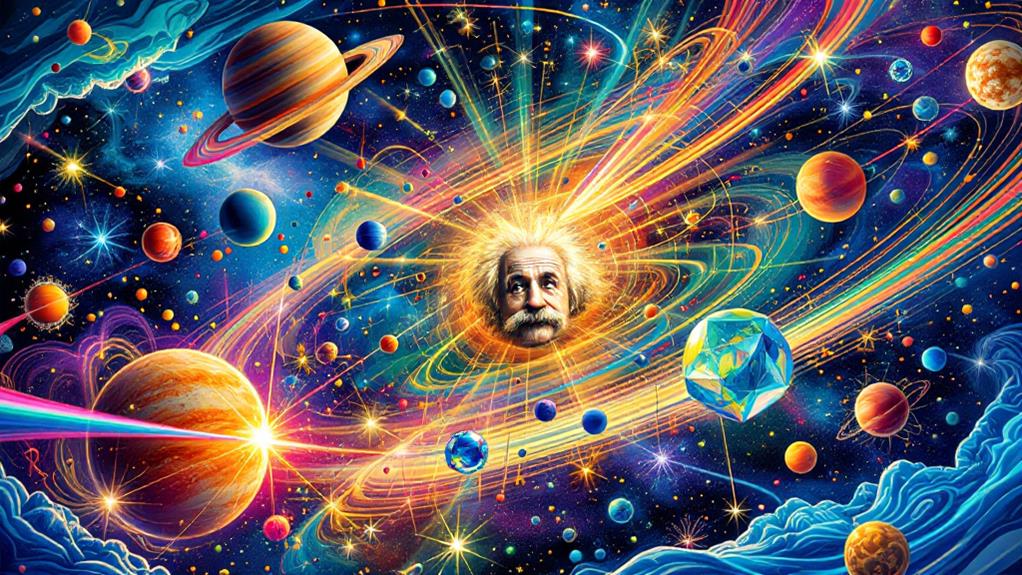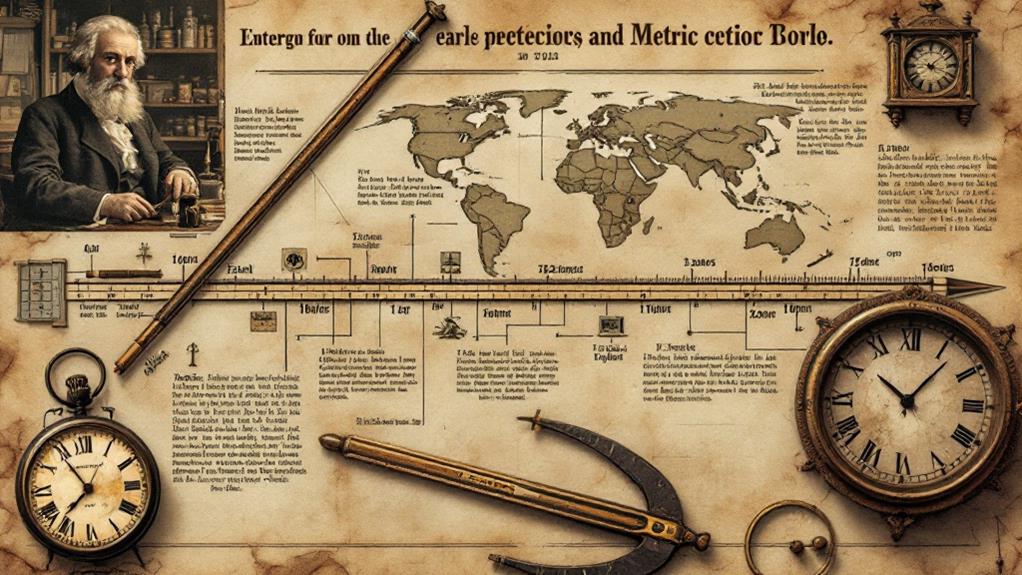Strange and Unusual Scientific Theories: Exploring the World’s Weirdest Ideas
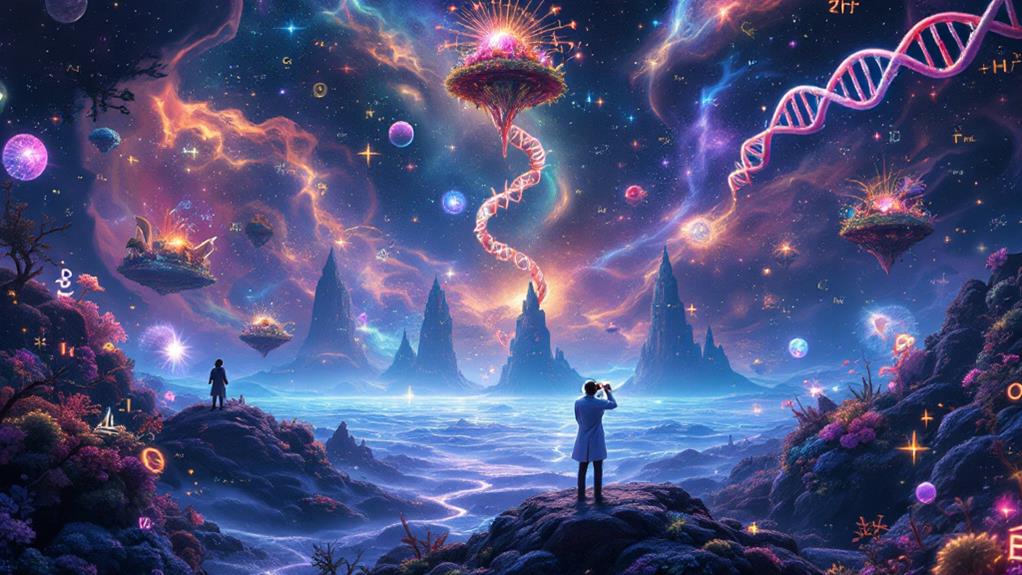
Prepare to set out on an exploration of bizarre and baffling scientific theories. Imagine a Hollow Earth filled with hidden civilizations or the possibility of time travel through cosmic anomalies. What if parallel universes exist, each shaped by quantum fluctuations, or reality itself is just a sophisticated simulation? Ponder the mysteries of dark matter, quantum immortality, and ancient astronauts shaping human history. The Gaia Hypothesis and Panspermia Concept challenge your understanding of life and Earth's interconnectedness. These weird ideas not only stretch the limits of imagination but also invite you to uncover more about these intriguing possibilities.
Hollow Earth Theory
The Hollow Earth Theory is one of those intriguing ideas that captivates the imagination with its bold claim: the Earth is hollow and possibly inhabited. You might wonder how this could be. Proponents suggest there are subterranean civilizations situated within vast echoing caverns, thriving in geothermal ecosystems. These hidden worlds could be accessed through polar openings, which some believe are gateways to an inner domain. This theory proposes an inner sun that provides light and warmth, creating a habitable environment deep beneath our feet.
Ancient maps, they argue, depict lands and paths that hint at this hidden domain, suggesting that ancient explorers might have known more than we do today. In addition, supporters of the Hollow Earth Theory point to magnetic anomalies as evidence of these underground territories. They claim these irregularities could be caused by the unique geological structures of a hollow planet.
Light phenomena, often unexplained by conventional science, are sometimes attributed to reflections or emissions from these subterranean territories. While mainstream science dismisses the idea, the notion of a hollow Earth with its own ecosystems and civilizations remains a fascinating investigation of what might lie beneath.
Time Travel Possibilities
Imagine bending the very fabric of time to investigate the past or glimpse into the future. It's a concept that has fascinated humanity for centuries, appearing in countless stories and scientific discussions. You might wonder if time travel is possible. While we haven't cracked the code yet, theories suggest intriguing possibilities.
One approach involves understanding temporal anomalies. These are irregularities or deviations from the expected flow of time. Scientists hypothesize that certain cosmic phenomena, like black holes, could create these anomalies. If you could exploit such a temporal anomaly, you might travel through time.
Then there's time dilation, a concept rooted in Einstein's theory of relativity. According to this, time isn't a constant; it can stretch or compress based on speed and gravity. Imagine traveling near the speed of light—time for you would slow down compared to those on Earth. This means you could leap forward in time without aging as much yourself.
While these ideas are speculative, they're grounded in scientific theory. They challenge your perception of time and hint at the tantalizing possibility that, one day, you might just step outside the linear confines of the present.
Multiverse Hypothesis
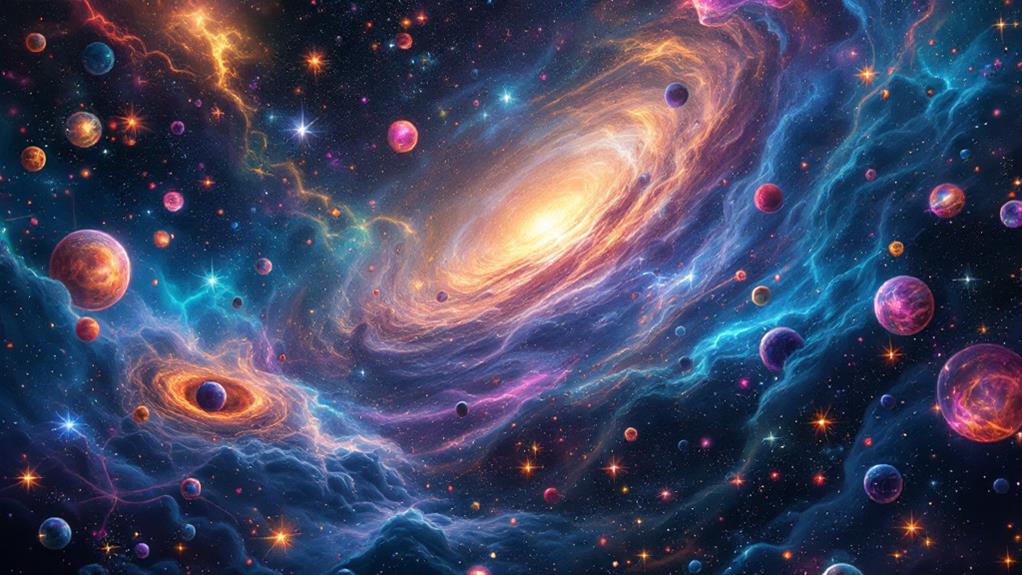
Step into the territory of the multiverse hypothesis, where reality expands beyond a single universe to a vast collection of parallel worlds. You're not confined to just one existence; instead, an endless array of alternate dimensions unfolds. Each universe may follow its unique course due to cosmic inflation, where rapid expansion results in infinite realities. These realities are shaped by quantum fluctuations, causing branching timelines and reality divergence.
As you explore deeper into multiverse exploration, consider these intriguing possibilities:
- Universe Collisions: Imagine universes occasionally intersecting, creating dimensional intersections. This could explain some of the mysterious phenomena we observe in our own universe.
- Parallel Timelines: In this scenario, every decision creates a new timeline, spinning off into its version of reality. Your life's choices could be playing out in countless parallel timelines.
- Dimensional Variation: Each universe might have its own set of physical laws, making them vastly different from our own. This diversity adds complexity to the multiverse landscape, where understanding these domains becomes a challenge.
In this fascinating hypothesis, the multiverse offers an infinite playground of possibilities, where universes evolve independently yet mysteriously intertwined.
Simulation Argument
While contemplating the vast possibilities of the multiverse, another fascinating theory emerges: the Simulation Argument. This intriguing idea suggests your entire reality might be nothing more than an advanced virtual reality, created by a highly sophisticated civilization. As you ponder this, consider the existential implications: if everything you perceive is a simulation, how do you define what's truly real? The concept challenges your perception of reality and raises questions about the nature of existence itself.
Technological advancement plays an essential role in this theory. As technology progresses, the likelihood of developing consciousness simulations increases. Imagine a future where computational limits no longer constrain such simulations. Would we then be able to replicate entire universes with conscious beings? The philosophical ramifications are mind-boggling, as they force you to reconsider free will and identity within this potentially fabricated existence.
Ethical considerations also arise. Should beings within a simulation be treated with the same moral regard as those outside it? These questions highlight the profound impact of the Simulation Argument on our understanding of the universe. Ultimately, this theory challenges you to rethink everything you know about consciousness and the very fabric of your perceived reality.
Dark Matter Mysteries
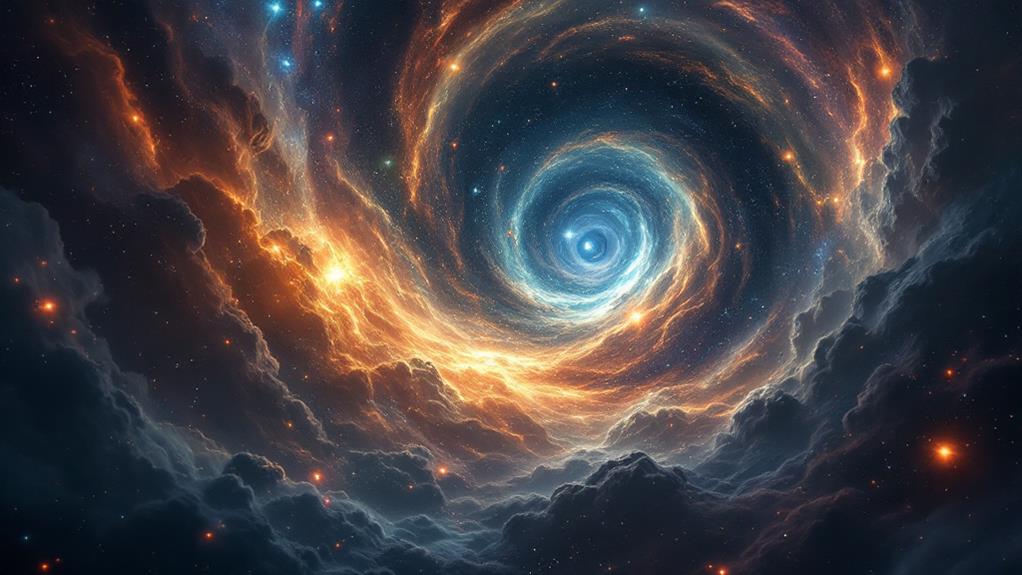
Shrouded in enigma, dark matter remains one of the most perplexing puzzles in modern astrophysics. You're drawn to investigate how its mysteries intertwine with the vast cosmos. Scientists have proposed several dark matter candidates, each with its own set of supersymmetry implications. These elusive particles are believed to interact weakly through dark sector interactions, influencing the universe's large scale structure.
When you consider dark energy interactions, the plot thickens. Together, dark matter and dark energy supposedly govern the universe's expansion. Their intriguing relationship is evident when observing the cosmic microwave background, providing clues about the universe's infancy.
But that's just the beginning. Gravitational wave effects and neutrino oscillations offer further insight into dark matter's role in galaxy formation theories. Astrophysical anomalies, such as unexplained gravitational behavior, hint at the unseen forces at play. To better grasp dark matter mysteries, here's what you should focus on:
- Dark Matter Candidates: Investigate potential particles and their properties.
- Supersymmetry Implications: Understand how supersymmetry theories relate to dark matter.
- Astrophysical Anomalies: Examine unexplained phenomena that suggest dark matter's presence.
Embracing these aspects can deepen your understanding of the universe's hidden intricacies.
Parallel Universes
Imagine a mirror reflecting not just your image, but an entire universe parallel to our own. This is the intriguing premise behind the theory of parallel universes. In these parallel dimensions, reality isn't fixed but influenced by quantum fluctuations. Every decision you make could create alternate timelines, branching off like cosmic strings weaving through time and space.
Picture a world where every possibility exists—where a dimensional rift might lead you into a mirror world that's both familiar and alien. These parallel existences challenge our understanding of existence, suggesting that reality shifts with each choice, creating a multitude of universes that coexist yet remain hidden from sight.
Time loops might occur, where events endlessly repeat, giving rise to universes where the past never truly becomes the past. In these alternate existences, cosmic strings could act as bridges, connecting different timelines and allowing for the exchange of energy and matter.
As you ponder this mind-bending concept, consider the implications: infinite versions of you, living out every possibility. The theory of parallel universes not only expands the boundaries of scientific exploration but also reshapes the way you perceive reality itself.
Quantum Immortality
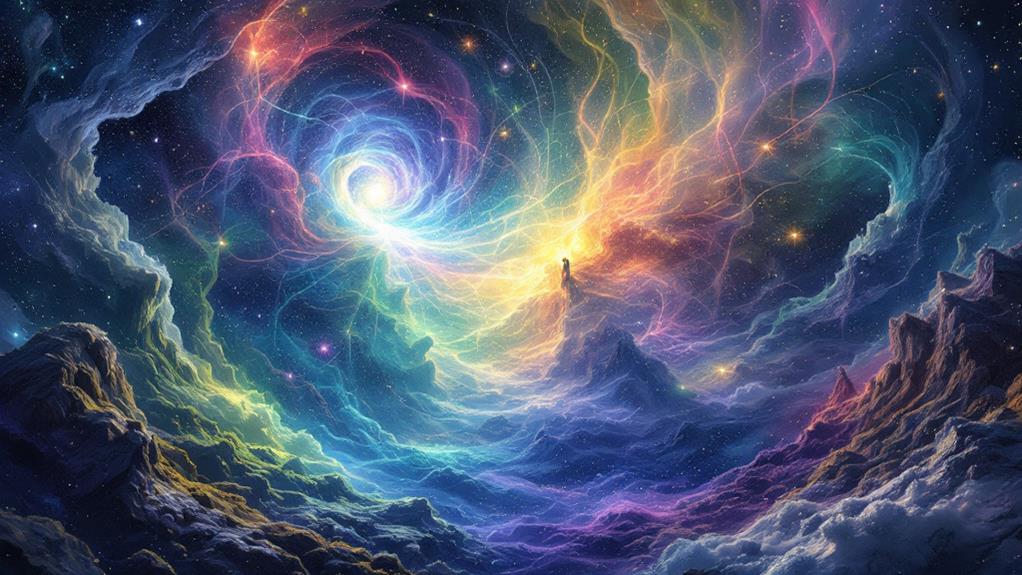
Quantum immortality is an intriguing idea that challenges your understanding of life and death. It posits that through quantum consciousness, your awareness continues to exist in alternate realities even after your physical body ceases to function in one. This concept is closely tied to the many-worlds interpretation of quantum mechanics, which suggests every decision spawns a new universe. Here, you never experience death because in some reality, you survive.
To understand this better, consider these points:
- Quantum Consciousness: This theory implies your consciousness can transcend across multiple realities. If you face a lethal event, your consciousness might shift to a universe where you survive, thereby achieving a form of immortality.
- Alternate Realities: Quantum immortality relies heavily on the existence of alternate realities. Each moment creates different possibilities and consequently, different versions of you continue to live in these realities.
- Survival and Decision: Every decision you make could lead to a different outcome in another reality. In one, you might face peril, but in another, you thrive, effectively bypassing death.
While quantum immortality is intriguing, it challenges conventional wisdom and remains largely theoretical, inviting you to ponder the vast possibilities of existence.
Ancient Astronauts
As you contemplate the mysteries of existence through the lens of quantum theories, another fascinating concept beckons your curiosity: the idea of ancient astronauts. This theory suggests that cosmic visitors played a crucial role in shaping ancient civilizations. Imagine alien artifacts buried beneath layers of forgotten histories, hinting at extraterrestrial influence that propelled human progress. Some believe these celestial beings shared lost technologies, enabling feats like the construction of monumental structures such as the pyramids or Stonehenge.
Interstellar communication might have been established, allowing cultural exchanges between humans and their mythological visitors. These interactions could explain the sudden advancements in mathematics, astronomy, and architecture seen in ancient cultures. Consider celestial navigation, a skill that seems to have appeared mysteriously, as a possible gift from these cosmic travelers.
The idea posits that mythological beings in different cultures, from the gods of ancient Greece to the deities of ancient Egypt, might be representations of these alien visitors. Was there a grand design behind these encounters, a purpose beyond our understanding? As you explore this theory, you're invited to question the origins of humanity's achievements and the potential hidden truths within our past.
Gaia Hypothesis
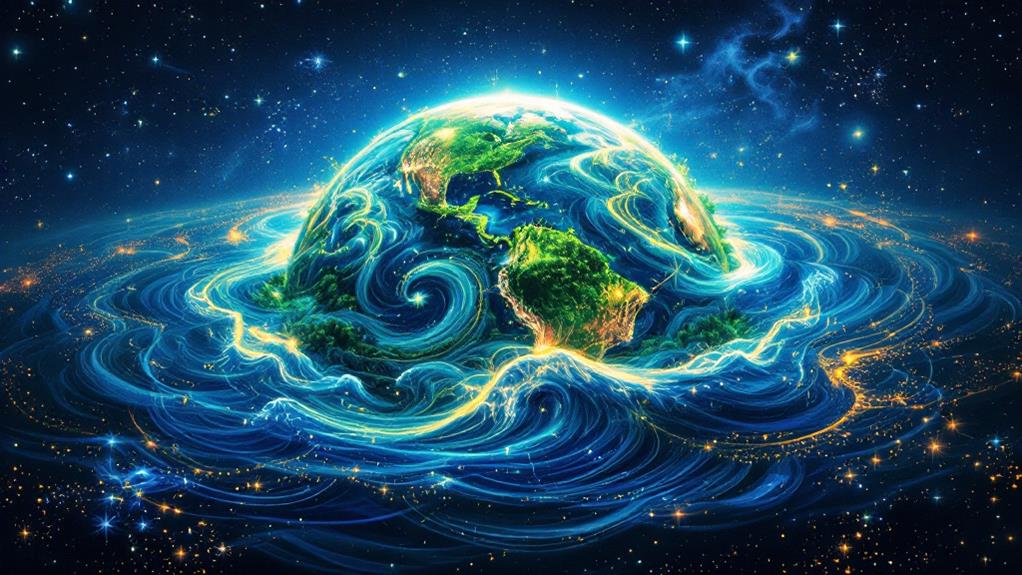
The Gaia Hypothesis offers a fascinating perspective on Earth, proposing that our planet operates as a single, self-regulating organism. You might wonder how this theory, known as the Gaia theory, aligns with our understanding of ecological balance and biosphere interactions. Imagine Earth as a living entity, where life systems and ecosystems work together to maintain planetary health and harmony.
In this holistic ecology framework, environmental feedback is essential. It's not just about individual species but how all elements of the biosphere interact to support the Earth's comprehensive well-being. This concept of planetary consciousness suggests that everything from microorganisms to massive forests plays a part in maintaining Earth's balance.
Consider these three significant aspects of the Gaia Hypothesis:
- Biosphere Interactions: Every organism and its environment influence each other, contributing to a self-regulating system.
- Ecosystem Harmony: Life systems collaborate, ensuring resources are available and conditions remain stable for all life forms.
- Planetary Health: The Earth's systems work in unison to sustain ideal living conditions, reflecting the planet's own form of consciousness.
Panspermia Concept
Among the most intriguing ideas in astrobiology, the Panspermia Concept suggests that life might have originated elsewhere in the universe and then spread to Earth. You're diving into a theory that entertains the notion of interstellar seeds—tiny life forms hitching rides on meteors, comets, or space dust. These seeds could have survived the harsh conditions of space, traveling vast distances before landing on a hospitable planet like Earth. It's a fascinating way to think about life's extraterrestrial origins.
You might wonder how cosmic microbiology supports this idea. Researchers have identified microorganisms that can endure extreme environments, from the vacuum of space to intense radiation. This resilience adds credibility to the Panspermia Concept, suggesting that life could indeed spread across planets. However, it also raises concerns about planetary contamination. If life can travel between planets, it's possible that missions investigating other worlds could inadvertently introduce Earth life to alien ecosystems, or vice versa.
The Panspermia Concept challenges you to reconsider how life began on Earth. It's more than just a theory; it's a call to investigate our cosmic connections and the potential for life beyond our planet.
